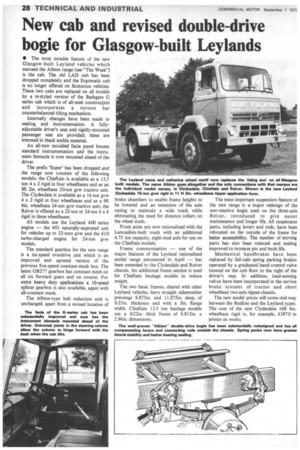New cab and revised double-drive bogie for Glasgow-built Leylands
Page 30

If you've noticed an error in this article please click here to report it so we can fix it.
• The most notable feature of the new Glasgow-built Leyland vehicles which succeed the Albion range (see "The Week") is the cab. The old LAD cab has been dropped completely and the Ergomatic cab is no longer offered on Scotstoun vehicles. These two cabs are replaced on all models by a re-styled version of the Bathgate G series cab which is of all-steel construction and incorporates a torsion bar counterbalanced tilting mechanism.
Internally changes have been made to seating and instrumentation. A fullyadjustable driver's seat and rigidly-mounted passenger seat are provided; these are trimmed in black ambla material.
An all-new moulded facia panel houses standard instrumentation and the instrument binnacle is now mounted ahead of the driver.
The prefix 'Super' has been dropped and the range now consists of the following models: the Chieftain is available as a 13.5 ton 4 x 2 rigid in four wheelbases and as an 8ft 2in. wheelbase 20-ton gcw tractive unit. The Clydesdale is available as a 16-ton gvw 4 x 2 rigid in four wheelbases and as a 9ft 6in. wheelbase 24-ton gcw tractive unit; the Reiver is offered as a 22-ton or 24-ton 6 x 4 rigid in three wheelbases.
All models use the Leyland 400 series engine — the 401 naturally-aspirated unit for vehicles up to 22-tons gvw and the 410 turbo-charged engine for 24-ton gvw models.
The standard gearbox for the new range is a six-speed overdrive unit which is an improved and uprated version of the previous five-speed constant-mesh box. The latest GB277 gearbox has constant mesh on all six forward gears and on reverse. For extra heavy duty applications a 10-speed splitter gearbox is also available, again with all-constant mesh.
The Albion-type hub reduction axle is unchanged, apart from a revised location of brake chambers to enable frame heights to be lowered and an extension of the axle casing to maintain a wide track while eliminating the need for distance collars on the wheel studs.
Front axles are now rationalized with the Lancashire-built truck with an additional 4.75 ton capacity, eight-stud axle for use on the Chieftain models.
Frame commonisation — one of the major features of the Leyland rationalized model range announced in April — has been extended to the Clydesdale and Reiver chassis. An additional frame section is used for Chieftain haulage models to reduce weight.
The two basic frames, shared with other Leyland vehicles, have straight sidemember pressings 9.875in. and 11.875in. deep, of 0.25in. thickness and with a 3in. flange width. Chieftain 13.5 ton haulage models use a 0.22in. thick frame of 9.812in. x 2.96in. dimensions. The most important suspension feature of the new range is a major redesign of the non-reactive bogie used on the three-axle Reiver, introduced to give easier maintenance and longer life. All suspension parts, including levers and rods, have been relocated on the outside of the frame for better accessibility. The number of moving parts has also been reduced and sealing improved to increase pin and bush life.
Mechanical handbrakes have been replaced by fail-safe spring parking brakes operated by a graduated hand control valve located on the cab floor to the right of the driver's seat. In addition, load-sensing valves have been incorporated in the service brake systems of tractor and short wheelbase two-axle tippelL chassis.
The new model prices will come mid-way between the Redline and the Leyland types. The cost of the new Clydesdale 16ft 4in. wheelbase rigid is, for example, £38.70 in primer ex works.


































































































